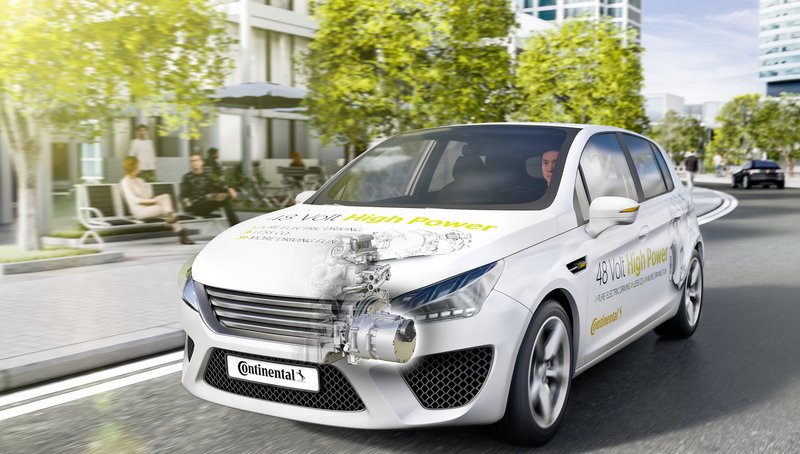Low Voltage, High Performance: Full-Hybrid Vehicle with 48-Volt High-Power Technology
- Electric-only driving in hybrid vehicles is enabled by 48-volt technology
- Same installation space, double the performance – innovative electric motor developed with up to 30 kW
- Advantages of the 48-volt high-power technology include its compactness, efficiency and cost-effectiveness
Regensburg, Hanover, July 2, 2019. Protecting the climate calls for environmentally efficient drive systems. For years now, technology company Continental has been backing environmentally friendly and cost-effective 48-volt electrification, which can be used with both gasoline and diesel engines. In the run-up to IAA 2019, Powertrain is now presenting the latest innovation to come from its 48-volt drive solution: the 48-volt high-power drive system with 30 kW.
A full-hybrid vehicle with 48-volt technology – this was previously deemed impossible. For a hybrid vehicle to drive using just electricity, the electric part of the drive would normally use high voltage technology – high voltages of up to 800 volts. However, Continental’s engineers have now succeeded in developing a 48-volt hybrid system that boasts features similar to those of a high-voltage electric drive, namely 48-volt high-power technology. “Thanks to its broad systems expertise, Continental Powertrain is mastering all variants of the electric drive, from 48-volt systems to hybrid technologies, right through to high-voltage components. We offer expertise and state-of-the-art technology from a single source,” said Andreas Wolf, CEO of Continental’s powertrain business. The new 48-volt high-power system, comprising an electric motor complete with integrated power electronics and a battery, reduces fuel consumption and thereby also CO2 emissions by around 20 percent compared with similar vehicles fitted with combustion engines. At the same time, the new 48-volt technology is also considerably cheaper than the high-voltage systems used up to now. “Our development objective was to achieve a level of driving efficiency with 48-volt technology that was previously reserved for high-voltage systems and we have now done exactly that,” said Stephan Rebhan, head of Technology & Innovation at Powertrain.
New stage of development: full hybrid without a complex, high-voltage system
The 48-volt systems were previously known as mild or P0 hybrids. They involve relatively unobtrusive electrification of the powertrain. Fuel consumption is reduced mainly by supporting the combustion engine during acceleration (boosting) and recovering excess kinetic energy when the vehicle decelerates (recuperation). However, purely electric driving is not possible with such systems, which Continental already manufactures for a number of automotive manufacturers. In the latest stage of development, the 48-volt system was repositioned in the powertrain. The electric motor was no longer placed in front of the combustion engine on the crankshaft, but behind it – between the combustion engine and transmission (P2 hybrid). This meant that fuel savings were able to increase and, in certain situations, such as driving through a 30 km/h speed limit zone, the vehicle could be driven using the electric motor alone.
With the new 48-volt high-power technology, this hybrid system enables the same functionality as previous, full-hybrid vehicles. The key component here is a new, water-cooled electric motor, the peak output of which was doubled to 30 kW in comparison with that used previously. Electric-only driving is therefore possible up to a speed range of 80 to 90 km/h.
The developers were able to achieve a 100 percent increase in power while maintaining the diameter of the motor. Overall, 48-volt high-power technology requires only slightly more installation space than the previous system. The difference in weight is also minimal.
However, the electric motor is not the only new component of the 48-volt high-power technology. The integrated power electronics also uses a new technology that now enables it to handle significantly higher currents. The innovations of the new 48-volt high-power technology result in a level of electrical efficiency that surpasses the previous system by almost 10 percent. And during recuperation (the recovery of excess kinetic energy when the vehicle decelerates), the new technology is much more effective than was previously the case, because the losses incurred in the electric drive system has been halved.
New hybrid technology making the most of what is currently technologically possible
The 48-volt high-power technology therefore provides all the benefits of a conventional, full-hybrid vehicle with a high-voltage system – significantly lower fuel consumption and CO2 emissions as well as optimized driving efficiency and drivability. There is also another argument in favor of the new hybrid solution from Continental, which is its relatively low costs. This is the key to making cheap hybrid vehicles available and achieving high market penetration. The reason for this is that a 48-volt system requires considerably less effort in terms of insulation protection, electrical components are smaller and cheaper, and even the design can be made significantly more compact, because smaller gaps are required between the individual components than is the case with high-voltage technology.
Continental is showcasing the new 48-volt high-power technology, which is also ready for series development, in a Ford Focus test vehicle. “With the new hybrid system, we are making the most of what is currently technologically possible for a 48-volt system,” said Stephan Rebhan. With the 48-volt high-power technology, Continental is playing a leading role in terms of performance, power density and efficiency. Full hybridization is made possible – all without the effort and costs involved in a high-voltage system.
Even a 48-volt plug-in hybrid drive would be possible
With an eye on the new approval regulations that have been in force since September 1, 2018, in accordance with the WLTP cycle, the 48-volt high-power technology could be developed even further. If, for instance, the system was supplemented by on-board charging technology and a larger battery, this would make even a plug-in hybrid drive featuring 48-volt technology possible. This is because the ability to drive in all-electric mode is no longer the main criterion for benefiting from the support for plug-in vehicles. Instead, it is the conversion of electrically stored energy into traction in general. The deciding factor for different funding initiatives is whether CO2 emissions can be reduced to below 50 g per kilometer.
Ein Voll-Hybrid-Fahrzeug mit 48-Volt-Technologie – bislang galt das als nicht realisierbar. Kann ein Hybrid-Fahrzeug auch rein elektrisch fahren, arbeitet der elektrische Teil des Antriebs üblicherweise mit Hochvolttechnik, also hohen Spannungen von bis zu 800 Volt. Den Ingenieuren von Continental jedoch ist es nun gelungen, ein 48-Volt-Hybridsystem zu entwickeln, das vergleichbare Merkmale wie ein Hochvolt-Elektroantrieb aufweist: die 48-Volt-High-Power-Technologie. „Dank der breiten Systemkompetenz beherrscht Continental alle Varianten des Elektroantriebs, von 48-Volt-Systemen über Hybrid-Technologien bis hin zu Hochvolt-Komponenten. Wir bieten Know-how und Hightech aus einer Hand", sagt Andreas Wolf, CEO des Antriebsgeschäftes von Continental. Das neue 48-Volt-High-Power-System aus E-Maschine mit integrierter Leistungselektronik sowie einer Batterie senkt den Spritverbrauch und somit auch den CO2-Ausstoß gegenüber vergleichbaren Fahrzeugen mit Verbrennungsmotor um rund 20 Prozent. Zugleich ist die neue Technologie auf 48-Volt-Basis deutlich kostengünstiger als die bislang verwendeten Hochvoltsysteme. „Unser Entwicklungsziel war es, mit 48-Volt-Technologie eine Fahreffizienz zu erreichen, wie sie bislang nur Hochvoltsystemen vorbehalten war. Das haben wir jetzt erreicht“, sagt Stephan Rebhan, Leiter Technology & Innovation Powertrain.

Simone Geldhäuser
Head of Media Relations, Spokesperson Finance, Business and Technology
Vitesco Technologies


